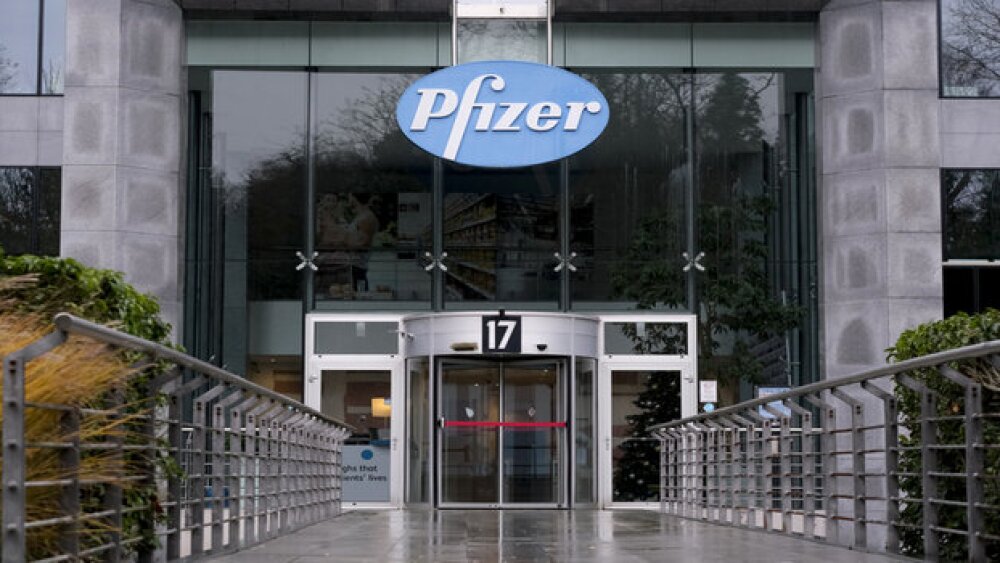In its second-quarter earnings reported Tuesday, Pfizer announced total revenues declined 54% to $12.7 billion, primarily due to a plummet in Paxlovid and Comirnaty sales.
Pictured: Pfizer in Brussels/iStock, Alexandros Michailidis
Pfizer’s second-quarter report Tuesday revealed it brought in revenue lower than forecasted as COVID-related sales plummeted more than expected. Looking ahead, the company trimmed the top end of its 2023 revenue range by $1 billion.
On the positive side, earnings for the pharma giant outpaced expectations at 67 cents a share over the 57 cents anticipated by analysts surveyed by FactSet.
The fall in revenue was anticipated as the COVID cliff loomed, but the drop was even steeper than estimated. Total revenues declined 54% for the quarter, compared to the prior year, reflecting an operational decline of $14.7 billion or 53%. Estimates had been set for $13.4 billion.
Sales for Pfizer’s COVID vaccine Comirnaty came in at $1.49 billion, down 83% from the second quarter of last year. Its COVID pill Paxlovid dropped 98% compared to the prior year, posting only $143 million in revenue. These products had raked in $17 billion in sales during 2022’s second quarter. Despite the drop, the company maintains its COVID revenue forecast for the year at $21.5 billion.
Fall sales of COVID products are expected to increase with vaccinations, but the company is prepared to launch a company-wide cost-cutting program “aligned with the longer-term revenue projections” if revenues are less than assumed. The program would be expected to yield results in 2024.
Pfizer narrowed the top end of its full-year sales forecast to $70 billion, from an initial outlook of $67 billion to $71 billion.
Excluding Comirnaty and Paxlovid, other revenues were up 5% at $11.1 billion, which the company accredited to recent acquisitions including Nurtec, a treatment for acute and episodic prevention of migraine in adults. Pfizer acquired the migraine drug, which posted $247 million in sales, in its $11.6 billion buy of Biohaven last year.
Oxbryta, a therapeutic for sickle cell disease, joined the fold last August when Pfizer paid $5.4 billion for Global Blood Therapeutics. The SCD therapeutic brought in $77 million for the quarter.
Second quarter’s pipeline update includes cuts of a pneumococcal vaccine and an RSV candidate. Pfizer also announced a deal last week to unload a portfolio of preclinical gene therapies and technologies to AstraZeneca’s subsidiary for a total consideration of up to $1 billion, plus tiered royalties on sales.
The company has been making deals in an effort to staunch the loss in revenue due to not only the post-pandemic cliff but also the seven products with patent expirations looming. The patent expirations will wipe out $17 billion in annual revenue by 2030.
The pharma giant forecasts revenues of $20 billion by 2030 from its new drug launches and new indications for current products and $25 billion from business development deals already completed.
The biggest deal remains up in the air as the FTC waits on additional information regarding Pfizer’s $43 billion buy of Seagen to add to its cancer portfolio.
Scrutiny on big pharma deals has increased at the FTC, citing concerns that the consolidation in the industry works against patients, keeping drug prices high and generics out of the market longer. In May, the FTC filed a lawsuit to block the smaller $28 billion merger between Amgen and Horizon Therapeutics. Amgen has filed a counter suit against the regulator.
Pfizer continues to tout an expected close by the end of this year or early 2024, but investors may be less convinced. Seagen stock is trading around $192, a hefty discount from Pfizer’s buy price of $229 per share.
If closed, the deal is expected to contribute over $10 billion in sales for Pfizer by 2030.
Kate Goodwin is a freelance life science writer based in Des Moines, Iowa. She can be reached at kate.goodwin@biospace.com and on LinkedIn.






